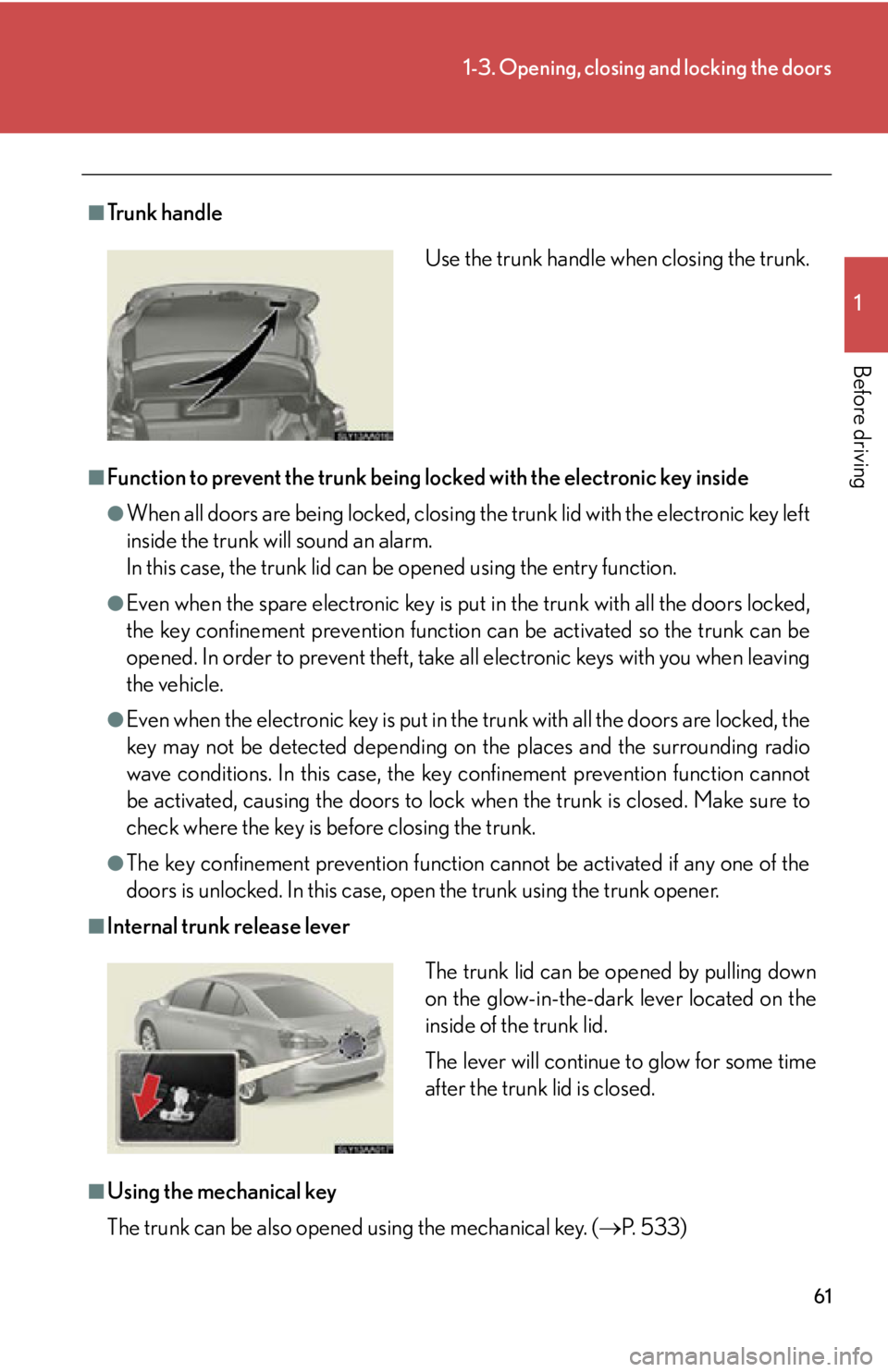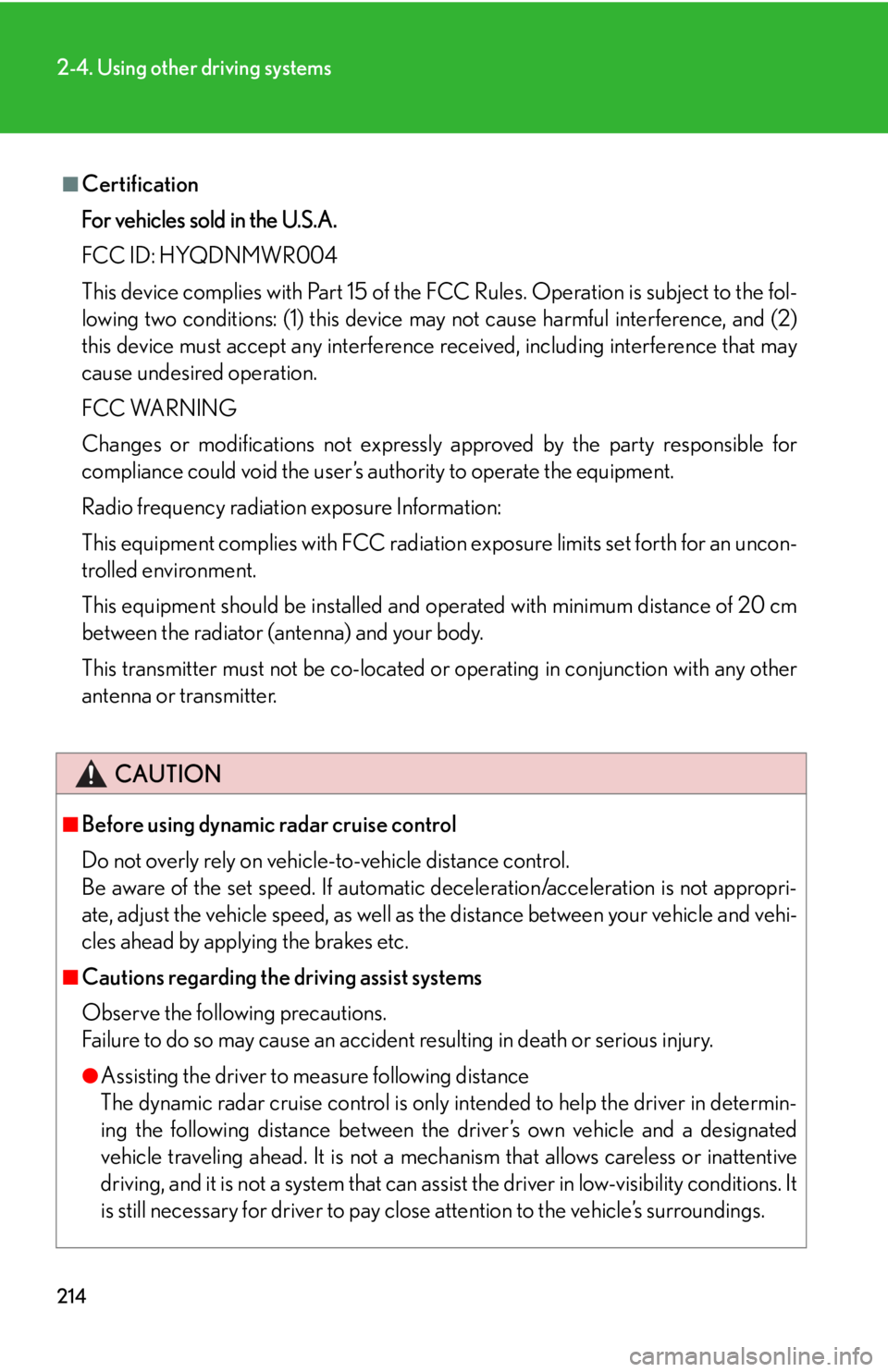Page 61 of 608

61
1-3. Opening, closing and locking the doors
1
Before driving
■Tr u n k h a n d l e
■Function to prevent the trunk being locked with the electronic key inside
●When all doors are being locked, closing the trunk lid with the electronic key left
inside the trunk will sound an alarm.
In this case, the trunk lid can be opened using the entry function.
●Even when the spare electronic key is pu t in the trunk with all the doors locked,
the key confinement prevention function can be activated so the trunk can be
opened. In order to prevent theft, take all electronic keys with you when leaving
the vehicle.
●Even when the electronic key is put in the trunk with all the doors are locked, the
key may not be detected depending on the places and the surrounding radio
wave conditions. In this case, the key confinement prevention function cannot
be activated, causing the doors to lock when the trunk is closed. Make sure to
check where the key is before closing the trunk.
●The key confinement prevention function cannot be activated if any one of the
doors is unlocked. In this case, open the trunk using the trunk opener.
■Internal trunk release lever
■Using the mechanical key
The trunk can be also opened using the mechanical key. ( P.
5 3 3 )
Use the trunk handle when closing the trunk.
The trunk lid can be opened by pulling down
on the glow-in-the-dark lever located on the
inside of the trunk lid.
The lever will continue to glow for some time
after the trunk lid is closed.
Page 114 of 608

114
1-8. Safety information
CAUTION
■Modification and disposal of SRS airbag system components
Do not dispose of your vehicle or perform any of the following modifications with-
out consulting your Lexus dealer.
The SRS airbags may malfunction or deploy (inflate) accidentally, causing death or
serious injury.
●Installation, removal, disassembly and repair of the SRS airbags
●Repairs, modifications, removal or replac ement of the steering wheel, instrument
panel, dashboard, seats, se at upholstery or rear seat side garnishes (padding),
front, side and rear pill ars or roof side rails
●Repairs or modifications of the front fender , front bumper, or side of the occupant
compartment
●Installation of snow plows, winches, etc. to the front grille (bull bars or kangaroo
bar etc.)
●Modifications to the vehi cle’s suspension system
●Installation of electronic devices such as mobile two-way radios and CD players
●Modifications to your vehicle for a person with a physical disability
Page 214 of 608

214
2-4. Using other driving systems
■Certification
For vehicles sold in the U.S.A.
FCC ID: HYQDNMWR004
This device complies with Part 15 of the FCC Rules. Operation is subject to the fol-
lowing two conditions: (1) this device may not cause harmful interference, and (2)
this device must accept any interference received, including interference that may
cause undesired operation.
FCC WARNING
Changes or modifications not expressly approved by the party responsible for
compliance could void the user’s authority to operate the equipment.
Radio frequency radiation exposure Information:
This equipment complies with FCC radiatio n exposure limits set forth for an uncon-
trolled environment.
This equipment should be installed and op erated with minimum distance of 20 cm
between the radiator (antenna) and your body.
This transmitter must not be co-located or operating in conjunction with any other
antenna or transmitter.
CAUTION
■Before using dynamic radar cruise control
Do not overly rely on vehicl e-to-vehicle distance control.
Be aware of the set speed. If automatic deceleration/acceleration is not appropri-
ate, adjust the vehicle speed, as well as the distance between your vehicle and vehi-
cles ahead by applying the brakes etc.
■Cautions regarding the driving assist systems
Observe the following precautions.
Failure to do so may cause an accident resulting in death or serious injury.
●Assisting the driver to measure following distance
The dynamic radar cruise control is only in tended to help the driver in determin-
ing the following distance between the driver’s own vehicle and a designated
vehicle traveling ahead. It is not a mechanism that allows careless or inattentive
driving, and it is not a system that can assist the driver in low-visibility conditions. It
is still necessary for driver to pay clos e attention to the vehicle’s surroundings.
Page 236 of 608
236
2-4. Using other driving systems
■Certification
For vehicles sold in the U.S.A.
FCC ID: HYQDNMWR004
This device complies with Part 15 of the FCC Rules. Operation is subject to the fol-
lowing two conditions: (1) this device may not cause harmful interference, and (2)
this device must accept any interference received, including interference that may
cause undesired operation.
FCC WARNING
Changes or modifications not expressly approved by the party responsible for
compliance could void the user’s authority to operate the equipment.
Radio frequency radiation exposure Information:
This equipment complies with FCC radiatio n exposure limits set forth for an uncon-
trolled environment.
This equipment should be installed and op erated with minimum distance of 20 cm
between the radiator (antenna) and your body.
This transmitter must not be co-located or operating in conjunction with any other
antenna or transmitter.
Page 250 of 608
250
3-1. Using the air conditioning system and defogger
Automatic air conditioning
system..................................... 252
Rear window defogger
switch ...................................... 260
Windshield wiper de-icer ...... 261
3-2. Using the audio system Audio system........................... 262
Using the radio ....................... 265
Using the CD player ............. 273
Playing MP3 and WMA
discs.......................................... 281
Operating an iPod
®
player ...................................... 288
Operating a USB memory
player ...................................... 296
Optimal use of the audio
system..................................... 304
Using the AUX adapter....... 307
Using the steering wheel
audio switches...................... 308
Interior features3
Page 262 of 608
262
3-2. Using the audio system
Audio system
Vehicles without a navigation system:
CD player with a changer and AM/FM radio
Vehicles with a navigation system:
Owners of models equi pped with a na
vigation system should refer to
the “Navigation System Owner’s Manual”.
Page 263 of 608
263
3-2. Using the audio system
3
Interior features
■Using cellular phones
Interference may be heard through the audio system’s speakers if a cellular phone is
be
ing used inside or close to the vehi cle while the audio system is operating.
Ti t l ePa g e
Using the radioP. 2 6 5
Using the CD playerP. 2 7 3
Playing MP3 and WMA discsP. 2 8 1
Operating an iPod® playerP. 2 8 8
Operating a USB memory playerP. 2 9 6
Optimal use of the audio systemP. 3 0 4
Using the AUX adapterP. 3 0 7
Using the steering wheel audio switchesP. 3 0 8
Page 265 of 608
265
3-2. Using the audio system
3
Interior features
Using the radio
Channel category buttons
“PWRVOL” k nob
Pow e r Vo l u m eTraffic information button
Preset station buttons
Scan button
Seek buttons
Radio text message button
Frequency adjustment
(AM/FM mode) and
channel (SAT mode)
knob
AMFM/SAT
mode buttons